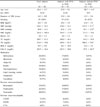1. Gregg EW, Sorlie P, Paulose-Ram R, Gu Q, Eberhardt MS, Wolz M, Burt V, Curtin L, Engelgau M, Geiss L. 1999-2000 national health and nutrition examination survey: Prevalence of lower-extremity disease in the US adult population ≥ 40 years of age with and without diabetes. Diabetes Care. 2004. 27:1591–1597.
2. Cui R, Iso H, Yamagishi K, Tanigawa T, Imano H, Ohira T, Kitamura A, Sato S, Naito Y, Shimamoto T. Ankle-arm blood pressure index and cardiovascular risk factors in elderly Japanese men. Hypertens Res. 2003. 26:377–382.
3. Kallio M, Forsblom C, Groop PH, Groop L, Lepantalo M. Development of new peripheral arterial occlusive disease in patients with type 2 diabetes during a mean follow-up of 11years. Diabetes Care. 2003. 26:1241–1245.
4. American Diabetes Association. Peripheral arterial disease in people with diabetes. Diabetes Care. 2003. 26:3333–3341.
5. Boulton AJM. Pickup JC, Williams G, editors. Foot problems in patients with diabetes mellitus. Textbook of Diabetes. 1997. 2nd ed. Oxford: Blackwell Science;58.1–58.20.
6. Reimer P, Landwehr P. Non-invasive vascular imaging of peripheral vessels. Eur Radiol. 1998. 8:858–872.
7. Piecuch T, Jaworski R. Resting ankle-arm pressure index in vascular diseases of lower extremities. Angiology. 1989. 40:181–185.
8. Stoffers HE, Kester AD, Kaiser V, Rinkens PE, Kitslaar PJ, Knottnerus JA. The diagnostic value of the measurement of the ankle-brachial systolic pressure index in primary health care. J Clin Epidemiol. 1996. 49:1401–1405.
9. Hiatt WR, Marshall JA, Baxter J, Sandoval R, Hildebrandt W, Kahn LR, Hamman RF. Diagnostic methods for peripheral arterial disease in the San Luis Valley Diabetes Study. J Clin Epidemiol. 1990. 43:597–606.
10. Feigelson HS, Criqui MH, Fronek A, Langer RD, Molgaard CA. Screening for peripheral arterial disease: the sensitivity, specificity, and predictive value of noninvasive tests in defined population. Am J Epidemiol. 1994. 140:526–534.
11. Criqui MH, Denenberg JO, Bird CE, Fronek A, Klauber MR, Langer RD. The correlation between symptoms and non-invasive test results in patients referred for peripheral arterial disease testing. Vasc Med. 1996. 1:65–71.
12. Kim DJ, Choi BJ, Ko YG, Chang HJ, Ahn CW, Ryu DR, Yun YS, Han SH, Nam JH, Park SW, Song YD, Lim SK, Kim KR, Shim WH, Lee HC, Huh KB. Risk factors for peripheral arterial disease as screened by plethysmography in patients with NIDDM. J Kor Diabetes Assoc. 1999. 23:172–181.
13. Chung YS, Yoo HJ, Seo SO, Kim HK, Kim DM, Yoo JM, Ihm SH, Choi MG, Park SW. Risk factors of peripheral vascular disease (PVD) and nutritional factors in diabetic patients over 60 years old complicated with PVD diagnosed by ankle-brachial index (ABI). J Kor Diabetes Assoc. 1999. 23:814–821.
14. Resnick HE, Lindsay RS, McDermott MM, Devereux RB, Jones KL, Fabsitz RR, Howard BV. Relationship of high and low ankle brachial index to all-cause and cardiovascular disease mortality: the Strong Heart Study. Circulation. 2004. 109:733–739.
15. Hooi JD, Stoffers HE, Kester AD, van Ree JW, Knottnerus JA. Peripheral arterial occlusive disease: prognostic value of signs, symptoms, and the ankle-brachial pressure index. Med Decis Making. 2002. 22:99–107.
16. Nam SH, Lee SO, Lee HW, Ryu BY, Kim HK, Choi CS. A study on clinical significance of ankle systolic pressure and ankle-brachial pressure index in chronic occlusive arterial disease. J Korean Soc Vasc Surg. 1995. 11:214–223.
17. Paumbo PJ, Melton LJ III. Harris MI, Hamman RF, editors. Peripheral vascular disease and diabetes. Diabetes in America. 1985. Bethesda, Md: NIH pub;No. 85-1468.
18. Tapp RJ, Shaw TE, de Courten MP, Dunstan DW, Welborn TA, Zimmet PZ. AusDiab Study Group: Foot complications in Type 2 diabetes: an Australian population-based study. Diabet Med. 2003. 20:105–113.






 PDF
PDF ePub
ePub Citation
Citation Print
Print




 XML Download
XML Download